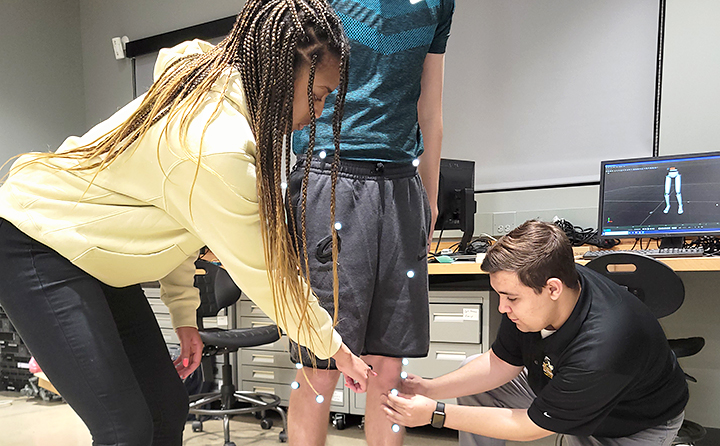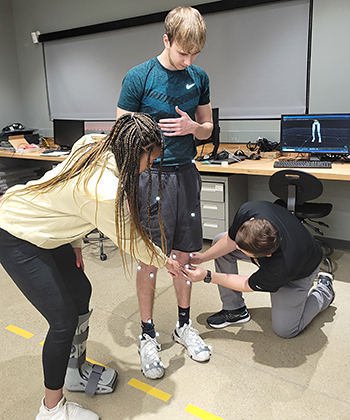An interdisciplinary research project is studying the physical and cognitive effects of anterior cruciate ligament (ACL) injuries with the goal of identifying factors that might put athletes at risk of secondary ACL injuries.

The faculty-student collaboration, which began last summer, is being led by three BW professors - Dr. Jennifer Kadlowec (engineering), Dr. Patrick Ledwidge (psychology and neuroscience) and Dr. Alexander Morgan (pre-allied health/pre-physical therapy).
The focus of the study is to analyze how athletes who have had ACL injuries and reconstructive surgery process and react to different environmental cues presented to them in a research setting. Also being examined are potential movement changes that may be attributed to ACL injury and surgery, as well as risk factors that might put athletes at a greater risk of a secondary ACL injury (which is an ACL injury that occurs after someone had an ACL tear before).
According to Morgan, the research team is still in the early stages of data collection with participants, who include athletes who previously injured their ACL, underwent ACL surgery reconstruction and then returned to playing their sport.
Participants are led through a series of two assessments - one using an electroencephalogram (EEG) which looks at cognition and the other focused on biomechanics.
For the EEG portion of the study, participants are taken to Ledwidge's Cognitive Neuropsychology Lab. Their brain waves are measured both while sitting and doing simple tasks on the computer and later while standing on one leg and doing the same tasks. Advanced technology in Ledwidge's lab allows the research team to assess cognitive differences between the sitting and standing positions to provide data about how the mind and body work together to support movement after ACL injury.
For the second part of the study, student researchers take participants to the BW Robotics and Biomechanics Lab, where movement of the skeleton is observed using a high-tech tracking device with an infrared camera.
Morgan and his research students will use that data to analyze the way in which athletes jump and land after ACL surgery. They hope their findings will provide educational information that can be used to help athletes avoid additional ACL injury.
The research team's abstract has been accepted into the International Society for Biomechanics in Sport conference. The team will travel to Milwaukee this July to present the feasibility study.
BW students from each of the disciplines are assisting the professors. Among them is Justin Blankenburg, a May 2023 graduate who majored in pre-athletic training and plans to attend graduate school this fall to earn a master's degree in athletic training. The Parma, Ohio, resident believes the research experience gave him a deeper understanding of biomechanics as well as improved his communication, collaboration, critical thinking and analytical skills.

Blankenburg went on to say that as an athletic trainer, he will practice evidence-based medicine, which means any injury prevention strategy or rehabilitation technique he uses would be thoroughly researched to ensure individuals receive the best care possible. The ACL research project gave him numerous opportunities to practice that skill in preparation for his career.
"Faculty-student collaboration at BW provides students with unique and personalized learning experiences. Students can gain a valuable mentor and a lifelong set of skills. This opportunity taught me many new and exciting things. I am sure many students and faculty would agree that a textbook can only take a student so far. Applying the information to a real-world scenario brings a whole new dimension to learning," he emphasized.
Also in agreement with the benefits of real-world learning is Alek Johnson '25, a Pittsburgh native studying engineering with the goal of pursuing a career in biomedical engineering.
"Working with kinematics and biomechanics provides me with knowledge I can apply in graduate school or in a career. This opportunity also is enhancing my analytical and problem-solving skills, which are essential in the engineering field," she noted.
"I have learned concepts and skills I can apply in and outside of the classroom. More importantly, I have been challenged to 'think differently' while participating in this project," remarked Johnson. "Working with other students allows different perspectives to be shared. I can use new knowledge and different perspectives to elevate and enhance my own level of thinking.
"Engineering is built around science, math, logic and how people think and analyze to problem-solve. This project has required many of these factors in an incredibly captivating way," she concluded.